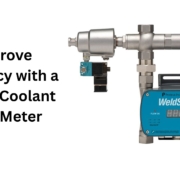Improve Accuracy with a Digital Coolant Flow Meter
Precision is essential in today’s industrial systems, especially when it comes to maintaining consistent cooling. A digital coolant flow meter is a crucial tool used across various industries to monitor and manage coolant flow accurately. Whether you are working in automotive manufacturing, electronics, or heavy machinery, digital coolant flow meters can help improve efficiency, prevent overheating, and extend equipment life.
This article explores how digital coolant flow meters work, their key features, industry applications, and how they enhance system performance. It also highlights the WeldSaver™ 5 Passport—a leading product that exemplifies the capabilities of advanced coolant flow monitoring.
What Is a Digital Coolant Flow Meter?
A digital coolant flow meter is an electronic device designed to measure the rate of coolant flow through a system with high precision. Unlike analog meters, digital models offer real-time readouts, data logging, and enhanced integration with control systems. These are commonly used in closed-loop cooling systems to ensure optimal thermal regulation and system reliability.
The meter continuously tracks the volume of coolant moving through pipes and sends feedback to monitoring systems. If flow rates deviate from preset thresholds, it can trigger alerts or system responses, helping prevent damage and downtime.
Introducing the WeldSaver™ 5 Passport
One of the most advanced digital coolant flow meter systems available today is the WeldSaver™ 5 Passport by Proteus Industries Inc. This product is specifically engineered for robotic and manual welding applications where precision cooling is critical.
Key Features of WeldSaver™ 5 Passport:
- Rapid Leak Detection: Identifies leaks in as little as 0.3 seconds, helping prevent equipment damage and fluid loss.
- Real-Time Flow and Temperature Monitoring: Ensures stable coolant performance during continuous operations.
- Automatic Shutoff Valve: Stops coolant flow immediately if unsafe conditions are detected.
- Passport Module: Allows for the easy duplication of system settings across multiple units, streamlining operations in large-scale facilities.
- Communication Interfaces: Supports Ethernet/IP, DeviceNet, PROFINET, and other protocols for seamless integration with industrial control systems.
The WeldSaver™ 5 Passport stands out for its reliability, speed, and versatility, making it a top choice for automated welding and other industrial applications that demand precise coolant monitoring.
Key Features of a Digital Coolant Flow Meter
Digital coolant flow meters come with advanced capabilities that set them apart from traditional meters. Here are the top features you can expect:
1. High Accuracy and Precision
These meters provide precise measurements, often within ±0.5% accuracy. This level of precision ensures that even the smallest fluctuations in flow are detected.
2. Data Logging and Storage
Many models come with built-in memory or external storage options, allowing for continuous logging of flow data. This is useful for performance analysis and predictive maintenance.
3. Programmable Alerts and Outputs
Digital meters can be programmed to send alerts or control outputs when flow rates go above or below safe levels. These outputs can be integrated with alarms, shutoff valves, or PLCs.
4. Compatibility with Various Fluids
These meters are designed to work with a wide range of coolants, including water, glycol blends, and specialty cooling fluids. Materials used are often corrosion-resistant and suitable for long-term industrial use.
5. Communication Interfaces
Support for communication protocols like Modbus, Ethernet/IP, PROFINET, and 4-20 mA outputs makes them easy to integrate into industrial automation systems.
Benefits of Using a Digital Coolant Flow Meter
Using a digital coolant flow meter offers numerous operational and financial advantages across industries:
1. Enhanced System Efficiency
Accurate flow readings help ensure that coolant is distributed efficiently, preventing energy waste and overheating. This contributes to better overall system performance.
2. Reduced Equipment Downtime
Monitoring coolant flow helps detect issues such as blockages, leaks, or pump failures early. Preventive actions can be taken before they escalate into costly repairs.
3. Improved Product Quality
Stable temperature control is vital for producing consistent results, especially in precision industries like electronics manufacturing production.
4. Real-Time Troubleshooting
Operators can identify problems on the spot using real-time data, reducing the time needed to diagnose and fix issues.
Choosing the Right Digital Coolant Flow Meter
To get the most out of your investment, consider these factors when selecting a digital coolant flow meter:
1. Fluid Compatibility
Ensure the meter materials are compatible with the type of coolant use, whether it’s water-based, glycol-based, or a specialty fluid.
2. Flow Range
Choose a meter that supports the correct flow range for your system.
3. Accuracy Requirements
If your process demands high precision, opt for meters with low margin of error.
4. Installation Type
Some meters are inline, while others are clamp-on. Choose based on ease of installation and space constraints.
5. Output and Communication Needs
Consider how the meter will integrate with your existing system. Make sure it supports your preferred data communication protocols.
6. Environmental Durability
In harsh environments, ensure the meter is resistant to corrosion, vibration, and temperature fluctuations.
Maintenance and Best Practices
To ensure longevity and reliability of your digital coolant flow meter:
- Calibrate Periodically: Regular calibration ensures accuracy over time.
- Clean Sensors: Prevent scale buildup or blockages that could affect readings.
- Monitor Trends: Use logged data to identify deviations and plan maintenance.
- Use Filters: Install coolant filters to prevent contaminants from damaging the sensor.
- Follow Manufacturer Guidelines: Always refer to the installation and maintenance instructions.
Conclusion
A digital coolant flow meter is a vital component for maintaining precise cooling performance in today’s complex systems. With real-time monitoring, programmable outputs, and seamless integration into automation platforms, these meters help reduce downtime, improve efficiency, and protect valuable equipment.
For industry-leading digital coolant flow monitoring solutions like the WeldSaver™ 5 Passport, Proteus Industries Inc offers high-performance meters designed for accuracy, reliability, and ease of integration into a wide range of industrial applications.

